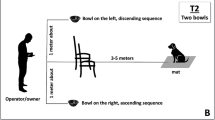The efficiency of the recognition of masked visual images (Arabic numerals) increased when accompanied by classical (62 dB) and rock music (25 dB). These changes were accompanied by increases in the coherence of potentials in the frontal areas seen on recognition without music. Changes in intercenter EEG relationships correlated with the formation a dominant at the behavioral level. When loud music (85 dB) and music of other styles was used, these changes in behavior and the EEG were not seen; however, the coherence of potentials in the temporal and motor cortex of the right hemisphere increased and the latent periods of motor reactions of the hands decreased. These results provide evidence that the “recognition” dominant is formed when there are particular ratios of the levels of excitation in the corresponding centers, which should be considered when there is a need to increase the efficiency of recognition activity in humans.
Similar content being viewed by others
References
A. V. Bogdanov and A. G. Galashina, “Time distribution of the linked spike activity of neurons in the sensorimotor cortex in rabbits with a rhythmic motor dominant,” Zh. Vyssh. Nerv. Deyat., 48, No. 4, 630–639 (1998).
N. N. Danilova, “Microstructural analysis of the gamma rhythm as a method for studying cognitive processes,” in: Questions in Neurocybernetics [in Russian], OOO “TsVVR” Press, Rostov-on-Don (2005), Vol. 1, pp. 16–18.
E. A. Kostandov, The Psychophysiology of Consciousness and Unconsciousness [in Russian], Piter, St. Petersburg (2004).
N. N. Lebedeva, R. A. Pavlygina, and V. I. Davydov, “Studies of a motor dominant in humans,” Zh. Vyssh. Nerv. Deyat., 41, No. 4, 647–654 (1991).
R. I. Machinskaya, N. O. Machinskii, and E. I. Deryugina, “Functional organization of the right and left hemispheres of the human brain in directed attention,” Fiziol. Cheloveka, 18, No. 6, 77–85 (1992).
R. I. Pavlygina, V. I. Davydov, A. V. Sulimov,Yu. V. Lyubimova, and D. S. Sakharov, “Analysis of EEG coherence on listening to music,” Zh. Vyssh. Nerv. Deyat., 53, No. 4, 402–409 (2003).
R. A. Pavlygina, D. S. Sakharov, and V. I. Davydov, “Interhemisphere EEG interactions on recognition of masked visual images accompanied by music,” Fiziol. Cheloveka, 34, No. 4, 11–18 (2008).
R. A. Pavlygina, D. S. Sakharov, and V. I. Davydov, “Spectral EEG analysis in humans on listening to musical performances,” Fiziol. Cheloveka, 30, No. 1, 62–69 (2004).
R. A. Pavlygina, D. S. Sakharov, and V. I. Davydov, “EEG characteristics determining the quality of subsequent recognition of visual images,” Fiziol. Cheloveka, 33, No. 1, 34–40 (2007).
R. A. Pavlygina, A. V. Sulimov, and L. A. Zhavoronkova, “Interhemisphere EEG relationships in a hunger dominant in humans (analysis of coherence), Dokl. Ros. Akad. Nauk., 338, No. 6, 833–835 (1994).
R. A. Pavlygina, M. V. Frolov, V. I. Davydov, G. B. Milovanova, and A. V. Sulimov, “Recognition of visual images in a rich sensory environment: musical accompaniment,” Zh. Vyssh. Nerv. Deyat., 48, No. 1, 19–29 (1998).
G. Ya. Roshchina, “Intercenter relationships between brain biopotentials in rabbits on creation of a blink dominant,” Zh. Vyssh. Nerv. Deyat., 41, No. 6, 1186–1192 (1991).
V. S. Rusinov, The Dominant. Electrophysiological Studies [in Russian], Meditsina, Moscow (1969).
E. V. Rusinov, “Intercenter relationships between electrical processes in the rabbit brain and a polarization dominant,” Zh. Vyssh. Nerv. Deyat., 36, No. 1, 133–139 (1986).
D. S. Sakharov,V. I. Davydov, and R. A. Pavlygina, “Intercenter EEG relationships in humans on listening to music,” Fiziol. Cheloveka, 31, No. 4, 27–32 (2005).
P. V. Simonov, The Emotional Brain [in Russian], Nauka, Moscow (1981).
V. B. Strelets, Zh. V. Garakh, V. Yu. Novototskii-Vlasov, and R. A. Magomedov, “Relationship between the power and synchronization of EEG rhythms in normal conditions and cognitive pathology,” Zh. Vyssh. Nerv. Deyat., 55, No. 4, 496–504 (2005).
A. A. Ukhtomskii, Collected Works [in Russian], Leningrad State University, Leningrad (1950), Vol. 1.
D. A. Farber and N. V. Dubrovinskaya, “Formation of neurophysiological functions in ontogeny. Mechanisms of human brain activity,” in: Human Neurophysiology [in Russian], Nauka, Leningrad (1988), pp. 426–455.
S. Agnes, Vim-Chi Ho, and Mei-Chun Cheung, “Music training improves verbal memory,” Nature, 398, 128 (1998).
M. Besson, F. Faita, and J. Requin, “Brain waves associated with musical incongruities differ for musicians and non-musicians,” Neurosci. Lett., 168, No. 1–2, 101–105 (1994).
D. Giannitrapani, “Scanning mechanisms and the EEG,” EEG Clin. Neurophysiol., 30, No. 2, 139–146 (1971).
G. J. Gorn, “The effects of music in advertising in choice behavior. A classical conditioning approach,” J. Marketing, 46, No. 1–2, 94–101 (1982).
N. Jausovec and K. Habe, “The influence of Mozart’s sonata K.448 on brain activity during the performance of spatial rotation and numerical tasks,” Brain Topogr., 17, No. 4, 207–218 (2005).
M. M. Mesulam, Principles of Behavioral Neurology, Davis Co., Philadelphia (1985).
T. Nakada, Y. Fujii, K. Suzuki, and I. L. Kwee, “‘Musical brain’ revealed by high-field (3 Tesla) functional MRI,” Neuroreport, 9, 3853–3856 (1998).
J. E. Patton, D. K. Routh, and T. A. Stinard, “Where do children study? Behavioral observations,” Bull. Psychonom. Soc., 24, No. 6, 439–440 (1986).
F. H. Rauscher, G. L. Shaw, and K. N. Ky, “Listening to Mozart enhances spatial-temporal reasoning: towards a neurophysiological basis,” Neurosci. Lett., 185, No. 1, 44–47 (1995).
W. J. Ray and H. W. Cole, “EEG activity during cognitive processing: influence of attentional factors,” Int. J. Psychophysiol., 3, No. 1, 43–48 (1985).
M. I. Tervaniemi, S. V. Medvedev, K. Alho, S. V. Pakhomov, M. S. Roudas, T. L. Van Zuijen, and R. Näätänen, “Lateralized automatic auditory processing of phonetic versus musical information: a PET study,” Hum. Brain Mapping, 10, No. 1, 74–79 (2000).
Author information
Authors and Affiliations
Corresponding author
Additional information
Translated from Zhurnal Vysshei Nervnoi Deyatel’nosti imeni I. P. Pavlova, Vol. 59, No. 5, 557–567, September–October, 2009.
Rights and permissions
About this article
Cite this article
Pavlygina, R.A., Sakharov, D.S., Davydov, V.I. et al. Influence of Music with Different Volumes and Styles on Recognition Activity in Humans. Neurosci Behav Physi 40, 877–884 (2010). https://doi.org/10.1007/s11055-010-9336-y
Received:
Accepted:
Published:
Issue Date:
DOI: https://doi.org/10.1007/s11055-010-9336-y




